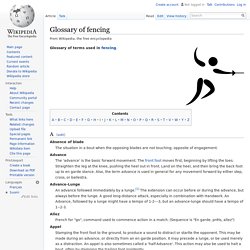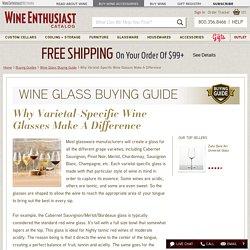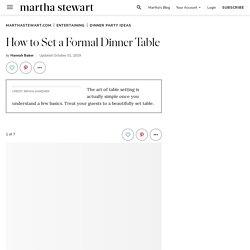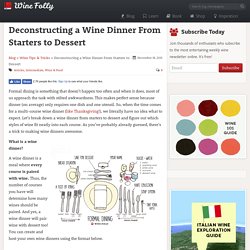

A Clever Radio Trick Can Tell If a Drone Is Watching You. Glossary of fencing. Glossary of terms used in fencing.

A[edit] Absence of blade The situation in a bout when the opposing blades are not touching; opposite of engagement. Advance The ‘advance’ is the basic forward movement. Advance-Lunge An advance followed immediately by a lunge.[1] The extension can occur before or during the advance, but always before the lunge. Allez French for "go", command used to commence action in a match. Appel Stamping the front foot to the ground, to produce a sound to distract or startle the opponent. Arrêt à bon temps see #Stop Hit. Assault A friendly combat between two fencers, where score may or may not be kept, and is generally not a part of any competition. Attack The initial offensive action made by extending the sword arm and continuously threatening the valid target of the opponent. Attaque au Fer An attack on the opponent's blade, e.g. beat, expulsion, pressure.
Why Varietal-Specific Wine Glasses Make A Difference. Most glassware manufacturers will create a glass for all the different grape varieties, including Cabernet Sauvignon, Pinot Noir, Merlot, Chardonnay, Sauvignon Blanc, Champagne, etc.

Each varietal specific glass is made with that particular style of wine in mind in order to capture its essence. Some wines are acidic, others are tannic, and some are even sweet. So the glasses are shaped to allow the wine to reach the appropriate area of your tongue to bring out the best in every sip. For example, the Cabernet Sauvignon/Merlot/Bordeaux glass is typically considered the standard red wine glass. It's tall with a full size bowl that somewhat tapers at the top. The Pinot Noir/Burgundy stems are not quite as tall as Bordeaux glass but will have a much wider bowl and sometimes will tulip towards the rim. Victoria & Albert's Orlando - Review & Photos. Roberts' Guide for Butlers and Household Staff - Robert Roberts - Google Books.
Marthastewart. "Once you realize table setting is based on logic, things become less intimidating," says etiquette consultant Pamela Hillings, author of "Manners in a Minute: Dining.

" For example, you begin eating a meal by using the flatware at the outside left and right, and then work toward the plate as the meal proceeds. Stemware is set above and to the right of the dinner plate; bread-and-butter plates sit above the plate and to the left. Flatware should align with the bottom rim of the charger, a large plate, which will be removed after everyone spreads his napkin on his lap (napkin rings, customary at family meals, may be used as a festive decoration). The water glass stands above the dinner knife, white wine to its right, and red wine top center. Pictorial Review: Victoria and Albert’s at Disney’s Grand Floridian Resort.
Welcome to the Disney Food Blog.

If you enjoy this post, you should check out the tour of the site to see all the great Disney Food information we have. Today we are sharing a pictorial review of the new Victoria and Albert’s Ten Course Tasting Experience from guest photographer, Tom Welsh. Thanks, Tom! Let’s take a closer look at a Chef’s Ten Course Tasting experience at Victoria and Albert’s. This award-winning restaurant at Disney World’s Grand Floridian Resort exudes elegance and is helmed by James Beard Award-nominee (again in 2016!) We took the monorail over to the Grand Floridian Resort for our dinner at Victoria and Albert’s.
The Amuse-Bouche was a Cauliflower Panna Cotta with Siberian Caviar and Tattinger Brut “La Francaise.” Cauliflower Panna Cotta with Siberian Caviar The nine courses that followed were: (2) Roulade of Smoked Salmon and Alaskan King Crab with Chateau Rahoul Blanc, Graves 2011. Smoked Salmon and Alaskan Crab Alaskan Sablefish Scottish Langoustine Truffled Chicken. Deconstructing a Wine Dinner From Starters to Dessert. Formal dining is something that doesn’t happen too often and when it does, most of us approach the task with stilted awkwardness.

This makes perfect sense because dinner (on average) only requires one dish and one utensil. So, when the time comes for a multi-course wine dinner (like Thanksgiving!) , we literally have no idea what to expect. Let’s break down a wine dinner from starters to dessert and figure out which styles of wine fit neatly into each course. As you’ve probably already guessed, there’s a trick to making wine dinners awesome. What is a wine dinner? A wine dinner is a meal where every course is paired with wine. Nearly all wine dinners follow a similar format starting with lighter, more delicately flavored wines (and food) and ending with bolder, more intense wines.
We created a theoretical 6-course meal to provide a myriad of pairing options for you to think about. Wine #1: Pairing with Hors d’oeuvres. Ladies' Book of Etiquette. Gentleman's Book of Etiquette. Untitled.